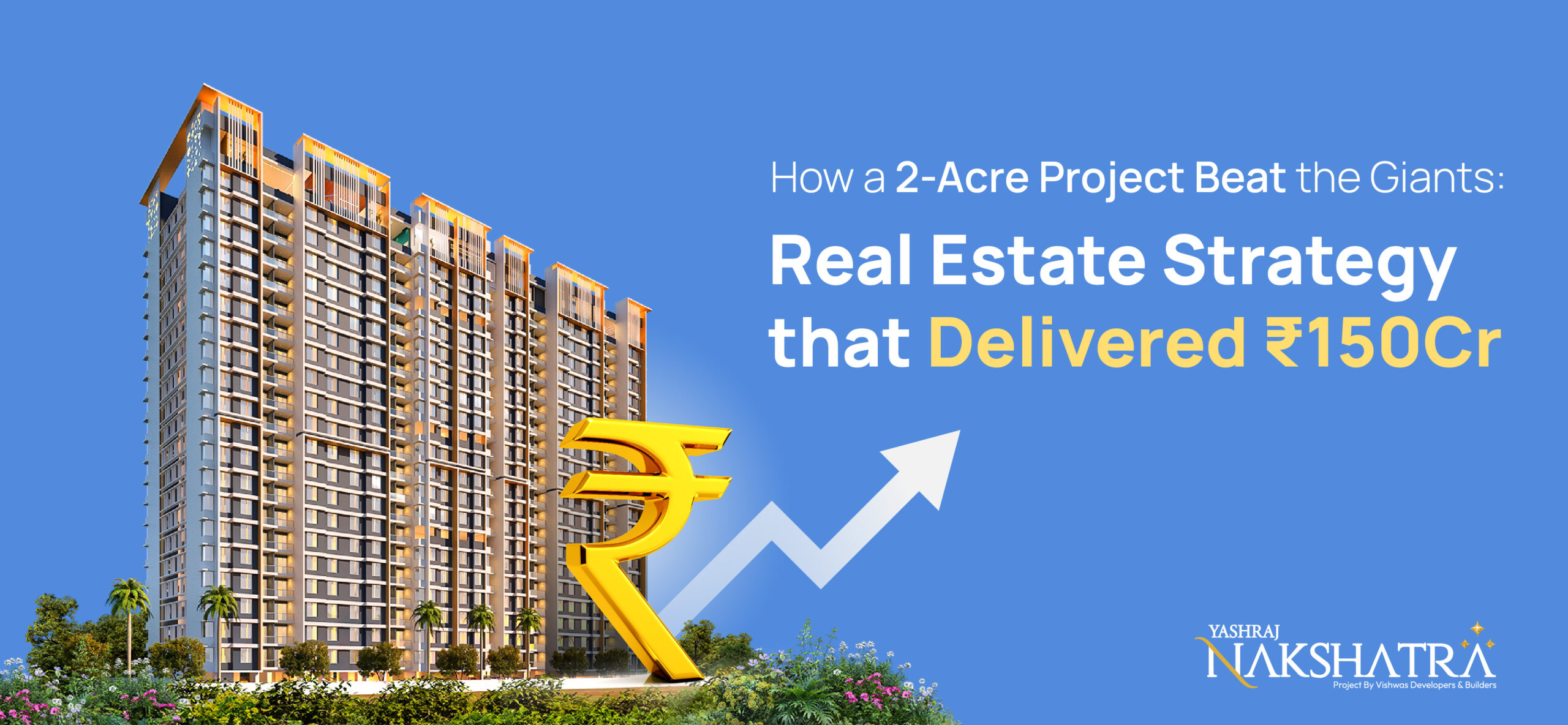Small real estate projects can compete by offering competitive pricing, efficient layouts, and targeting specific buyer needs through localized marketing and personalized sales efforts.
How a 2-Acre Project Beat the Giants: Real Estate Strategy that Delivered ₹150Cr

In a market dominated by large-scale developments and legacy brands, Yashraj Nakshatra, a 2-acre residential project in Hadapsar, delivered a standout performance. Despite its modest scale and minimal brand equity, the project generated ₹150Cr+ in sales and achieved 350+ bookings within just 18 months.
What set Nakshatra apart was its expert strategy. Launched during a period of buyer hesitation and oversupply, it challenged market norms by focusing on usable space over built-up area, design efficiency over amenity bloat, and local relevance over generic branding.
Positioned smartly with a strong value proposition, the project attracted serious buyers by doing a few things exceptionally well: creating intelligent layouts, hitting the right price-to-product balance, and delivering sharp, emotionally resonant messaging tailored to its micro-market.
This is the study of how one small parcel, powered by clear thinking and precise execution, outperformed expectations and redefined what success looks like for real estate developers.
Real Estate Context & Market Challenges
At the time of launch, Pune’s real estate market was facing headwinds:
- Inventory overhang in key corridors like Hadapsar
- Price-sensitive buyers delaying decisions due to rising interest rates
- Oversupply of 2BHKs from large developers
Yet, Yashraj Nakshatra found a way to stand out by responding to the unmet needs of the Hadapsar buyer.
Most competing projects in the area were pushing 730–750 sq.ft. 2BHKs with wide passages, oversized balconies, and formal entryways that looked good on paper but ate into usable room sizes. These layouts often resulted in oddly shaped master bedrooms or squeezed living areas. Buyers noticed.
At the same time, ticket sizes were breaching the ₹60L–₹70L mark for similar configurations in large-format developments, despite offering sprawling amenity decks, made buyers feel increasingly disconnected from the actual lifestyle needs of nuclear families and working professionals.
The emotional sell of “township living” was wearing thin. In local site visits, buyers began questioning why they were paying premiums for clubhouses they’d rarely use or branded kitchens they’d likely renovate.
Interest rates were also climbing, from sub-7% levels in early 2022 to over 8.5% by mid-2023, making EMI sensitivity a critical factor in deal closures. Many potential buyers postponed decisions or began hunting for lower-priced inventory without compromising functional space.
On the developer front, big names had strong visibility in East Pune, commanding attention with multi-phase launches and expansive marketing. Their media share made it harder for smaller players to be trusted.
In this context, a small-format project with a limited number of units and no celebrity campaign, should have been overlooked.
But Yashraj Nakshatra wasn’t.
Instead of mimicking the market, it listened to it and created a product that solved very specific buyer frustrations:
- No wasted square footage
- Usable bedrooms and living spaces
- Pricing that stayed under ₹55L for a functional 2BHK
- Clear value communication rooted in local language and behavior
That’s what made Nakshatra visible and viable. Which buyers eventually preferred.
On-Ground Challenges
- Brand Trust vs. Known Competitors: Despite a strong product offering, Yashraj Nakshatra faced the uphill task of competing against well-established developers with decades of brand equity. Buyers in the Hadapsar area were often drawn to the bigger names in the market, preferring the comfort of familiarity over the risk of an unknown project. Establishing credibility without the backing of a legacy brand was a critical challenge.
- Site Constraints: The project was located on a compact 2-acre parcel, limiting its ability to offer large-scale amenities like its bigger competitors. The shape and size of the land posed a design challenge, the project had to be efficient and creative, maximising every inch without sacrificing quality.
- Market Skepticism: With buyer hesitation at an all-time high, especially due to rising interest rates, many potential customers were hesitant to commit. Compounding this was the oversupply of inventory in the area, making it difficult to cut through the noise and prove that Nakshatra was the right choice. Despite its smaller size, the project had to convince buyers that it was not only affordable but also the right long-term investment.
- Breaking Through Media Noise on a Limited Budget: Unlike the large-scale developments with massive marketing budgets, Yashraj Nakshatra had to make an impact with a leaner marketing spend. Competing for attention against well-funded media campaigns from big developers meant finding smarter, more effective ways to reach its target audience without burning through resources. Being a smaller player, Nakshatra had to adopt a highly targeted, digital-first approach while still maintaining a strong offline presence in local hotspots.
- Limited Units, High Expectations: With a smaller number of units available, the pressure to convert every lead was immense. The fear of not meeting sales targets or inventory running unsold was a real concern. Balancing demand, managing expectations, and ensuring smooth conversion from lead to sale required a fine-tuned sales strategy, alongside an engaging onsite experience.
Strategic Game Plan
Yashraj Nakshatra’s success was a result of a carefully executed strategy that stood out in a competitive market. By focusing on key elements that directly addressed buyer concerns and aspirations, the project managed to not only gain attention but convert that interest into sales. Here’s a breakdown of the four pillars that made the strategy a success:
Product Design Excellence
- Smart space utilisation: Compact, efficient units with no wasted space, making the 655 sq.ft flats feel bigger than their size.
- Well-curated amenities: Focused on essential amenities that catered to the needs of nuclear families and working professionals.
- Vastu/ventilation-focused layouts: Ensured natural airflow and alignment for better comfort and harmony in daily living.
Positioning & Branding Strategy
- Clarity in messaging: Clear communication of the project’s affordability, functional design,
and
strong community connections.
- Emotional hooks: Focused on first-home pride, family-friendly spaces, and a sense of
belonging,
which resonated with the target audience.
- Visual identity: A consistent, appealing logo, a cohesive colour palette, and an impactful
campaign line that connected emotionally with the local market.
Marketing Engine
- Digital-first campaigns: Targeted, cost-effective campaigns across social media platforms,
Google
Ads, and hyper-local websites.
- Local lead generation: Utilised WhatsApp, IVR systems, and real estate portals to directly
engage
with potential buyers.
- Offline hooks: Combined online efforts with impactful offline marketing, including hoardings,
site branding, and engaging launch events to maintain visibility.
Sales Strategy & Conversions
- Lead follow-up strategy: A well-organised lead follow-up process to ensure no prospect was
left
behind.
- CRM/automation: Used CRM systems and automation tools like drip follow-ups and remarketing to
stay in constant touch with leads.
- Site visit experience: Structured, seamless site visit experiences, with a clear conversion
flow
to turn interest into sales.
By blending strong design, strategic positioning, cutting-edge marketing, and an efficient sales process, Yashraj Nakshatra demonstrated how a thoughtful, precise approach could overcome the hurdles faced by small-scale projects.
Results
The results of Yashraj Nakshatra’s strategy speak for themselves:
- 5,000+ Total Site Visits: Achieved through high-impact digital campaigns, optimized creatives, and targeted media planning across key platforms.
- 2,000+ Direct Site Visits: Driven by strong brand recall from remarketing, local outreach, and consistent messaging across touchpoints.
- 350+ Bookings: Enabled by seamless lead management, timely follow-ups, and close coordination between marketing and sales teams.
- ₹150Cr+ Revenue Generated: Resulted from focused targeting, strong product-market fit, and effective positioning in a competitive market.
- 18-Month Timeline: Paced through well-phased campaigns that balanced awareness, engagement, and conversion with agility.
- 4% Mandate Cost: Delivered through disciplined budgeting, performance tracking, and continuous campaign optimization.
This strong performance proves that a clear, focused strategy can yield impressive results, even for smaller projects.
Key Success Factors and Learnings
Here’s what real estate developers can learn from Yashraj Nakshatra’s success:
- Market Timing + Niche Positioning: Launching at the right time, tapping into the specific needs of price-sensitive buyers in a saturated market.
- Strategic FSI Use & Layout Planning: Using space efficiently, maximising usable room, and overcoming site constraints with smart layouts.
- High-Intent Lead Focus Over Vanity Reach: Focusing on high-quality leads, prioritising conversions instead of broad, unqualified outreach.
- Unified Design, Sales, and Marketing Flow: Aligning design, branding, and sales strategies to ensure a seamless, cohesive buyer journey.
- Targeted, Digital-First Marketing: Leveraging cost-effective digital platforms and hyper-local campaigns to engage the right audience effectively.
- Clear Value Proposition: Communicating functional living spaces, affordability, and a community-focused lifestyle that resonates with buyers.
- Emotional Connection Over Legacy Branding: Building trust with buyers through thoughtful design and emotional appeal, instead of relying on well-known brand names.
Conclusion
Yashraj Nakshatra proves that success in real estate is about clarity, precision, and a focused strategy. Despite being just a 2-acre development in a market dominated by large players, Nakshatra generated ₹150Cr in sales and over 350 bookings in just 18 months. By addressing buyer pain points and focusing on functionality, affordability, and local relevance, the project stood out as a smart, well-executed alternative.
Yashraj Nakshatra also highlighted the significance of emotional connection over legacy branding, proving that today’s buyers care more about the product’s value than the name behind it. The project achieved success not by mimicking larger developments but by creating a solution that resonated with the real needs of its audience.
In essence, Nakshatra’s success redefines the traditional idea that bigger projects always win. With the right strategy, even small projects can outperform the competition.
Ready to learn more and apply these insights to your own project? Schedule a free consultation with BeyondWalls today and let’s explore how we can help you achieve similar success. Together, our expertise in MarTech and your superior construction can turn your vision into a profitable reality.
FAQ
Cost-effective real estate marketing strategies include social media ads, Google PPC, listing on property portals, and using CRM tools to automate follow-ups.
To reduce CPL, refine your audience targeting, optimize ad creatives, test multiple channels, and monitor analytics to focus budget on top-performing sources.
Optimize space by minimizing common areas, using open floor plans, integrating smart storage, and ensuring good light and ventilation for all units.
Offering fewer amenities with a lower price point can attract budget-conscious buyers, especially in oversupplied markets where affordability matters most.
Trust can be built by delivering quality construction, being transparent about pricing and timelines, and maintaining consistent communication with buyers.
Thank you. Your comment will be visible after an approval.
Comments (0)
No comments found.






Add your comment